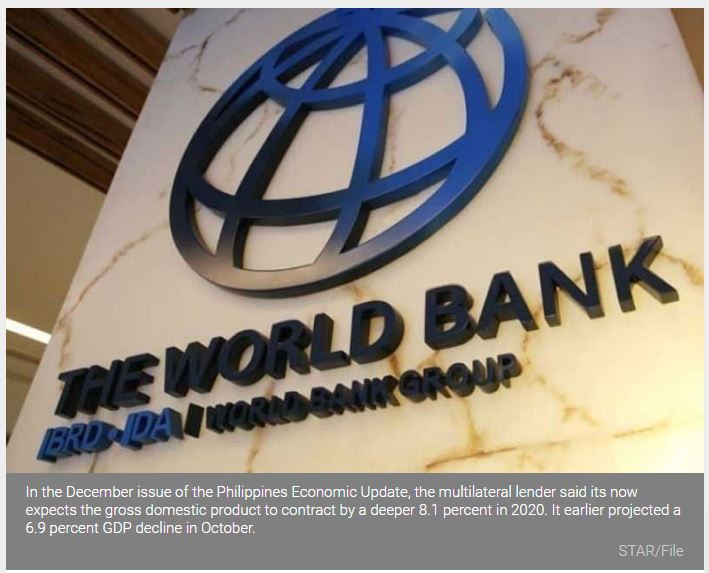World Bank further downgrades economic forecast for Philippines
MANILA, Philippines — The World Bank has downgraded its economic forecast for the Philippines this year following the still steep decline in output in the third quarter and the onslaught of devastating typhoons last month.
In the December issue of the Philippines Economic Update, the multilateral lender said its now expects the gross domestic product to contract by a deeper 8.1 percent in 2020. It earlier projected a 6.9 percent GDP decline in October.
The WB said the revision takes into consideration the steep contraction of 11.5 percent in the third quarter, as well as the extensive damage and losses incurred from the string of typhoons that battered the country in November.
Typhoons Rolly, Siony and Ulysses hit the country last month in a span of two weeks, devastating a large portion of Luzon.
Before these typhoons, the economy had already suffered a 10 percent contraction in the first three quarters, the worst since the 1985 debt crisis, because of pandemic-related quarantine measures. For most of the year, there was a plunge in domestic demand, investment activities and exports.
The combination of the pandemic and natural disasters that hit the country also threatens to temporarily reverse gains made in poverty reduction in recent years, the WB said.
As of August, around 40 percent of households reported a slide in income either from employment or business.
“While the Philippines is financially resilient, stronger coordination, execution and implementation will help further improve social and physical resilience to frequent shocks,” said WB country director Ndiame Diop.
He said sustained improvements in managing the pandemic and a possible rebound in the global economy can help the country wriggle out of the pandemic-induced slump in 2021 and 2022.
The current forecast hinges on China’s early recovery alongside the expected rebound in global recovery in 2021, which will allow for the recovery of exports and larger remittance inflow.
WB senior economist Rong Qian noted that for next year, remittances are expected to rise alongside the global economic recovery because of the Filipino tradition of sending more to families in times of crises.
Assuming that the infection curve continues to flatten and the economy reopens more, the economy can bounce to a 5.9 percent growth in 2021 and six percent in 2022 as jobs and incomes are restored.
The government is also expected to ramp up its infrastructure spending starting in the fourth quarter of 2020, creating jobs in the construction sector.
Pre-election activities in the runup to the national election in 2022 would also give an additional boost to demand as early as in the second half of 2021.
The likelihood that a vaccine would be successfully rolled out in the country next year was factored into the revised forecast but if it would be widely available next year, this would be an upside to the forecast because recovery would be faster, said Qian.
A renewed spike in COVID-19 cases as well as the frequency of natural disasters remain a major downside risks.
“While addressing the pandemic, the country needs to sustain focus on the structural reform agenda,” said Qian.
“Speeding up reforms that improve the business environment, foster competition, and strengthen resilience against natural disasters will support the economic recovery and boost productivity growth in the long term.”
Source: https://www.philstar.com/business/2020/12/09/2062394/world-bank-further-downgrades-economic-forecast-philippines


 English
English




